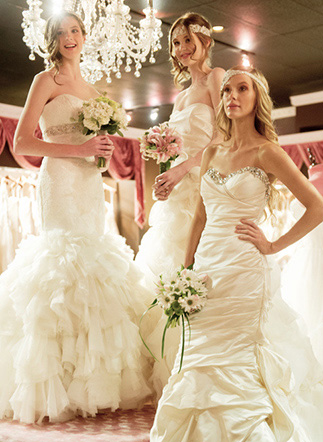Wedding Dress Fabrics: A Guide To The Most Popular Types
Choosing the right wedding dress is key to finding a gown that creates your dream silhouette and feels comfortable throughout your celebrations. This guide introduces you to the most popular wedding dress fabrics and what makes each one unique.
Satin
First up is satin, a high-sheen, heavy fabric perfect for structured gowns due to its sturdy nature. Although technically not a fabric but a finish, ‘satin’ commonly refers to a heavy, matte fabric with a glossy surface. Its high-shine makes it ideal for evening weddings or cooler weather, and it works beautifully on a-line dresses or mermaid gowns. Remember, satin’s weight may not be favorable for summer weddings or beach ceremonies.
Chiffon
Chiffon is a lightweight, sheer material typically used in overlays or sleeves. It is perfect for achieving an ethereal, airy style due to its delicate and fluid draping. Chiffon dresses lend themselves well to beach or summer weddings, thanks to their lightweight nature. However, the fabric’s sheer aspect means it’s usually layered or used alongside other materials to maintain modesty.
Tulle
This net-like, sheer fabric is ideal for adding volume to skirts or creating a dreamy, fairy tale look. Tulle is lightweight and moves well, making it great for full A-line skirts or princess-style ball gowns. It’s often used with embellishments like lace or sequins, but be careful- tulle can tear easily due to its netted structure.
Organza
A close cousin to chiffon is organza. This sheer, lightweight fabric has more structure than chiffon, making it great for creating shape without adding weight. Organza is often used for skirts, overlays, and sleeves, thanks to its lightweight and slightly sparkly nature. While it offers more structure than chiffon, organza is still gentle – it can fray easily and requires careful handling.
Lace
Regarded as a classic wedding dress material, lace injects antique charm and detail into your gown style. There are multiple lace types, such as Chantilly (delicate and detailed), Alençon (featuring a bold floral design), and Venise (thick and textured). Lace can overlay a solid base fabric or serve as detailed accent elements on the neckline, sleeves, or hemline. Lace gowns flow nicely and allow for detailed designs, although the fabric can be delicate and prone to snagging.
Crepe
Crepe is a light, soft fabric with a crinkled surface that clings to the body. It is perfect for creating gowns that highlight your shapes, like a sheath or mermaid. With its beautiful drape and subtly glossy finish, crepe is an elegant choice for a minimalist wedding dress. Though it’s lightweight, crepe isn’t transparent and provides shape without feeling heavy, making it optimal for warmer venues or seasons.
Charmeuse
A lightweight, shiny fabric that drapes beautifully, charmeuse gives a similar look to satin but without the weight. It is perfect for creating flowing, sleek silhouettes due to its soft structure and slight sheen. However, the clingy material will emphasize every curve and crease, so be aware of your comfort level with this form-fitting look.
Dupioni
Dupioni silk offers a rustic elegance. It is similar to raw silk and is characterized by its irregular, rough finish. Its texture creates a unique sheen and depth that adds interest to simple dress shapes. Dupioni is a heavier fabric and ideal for cooler wedding venues.




